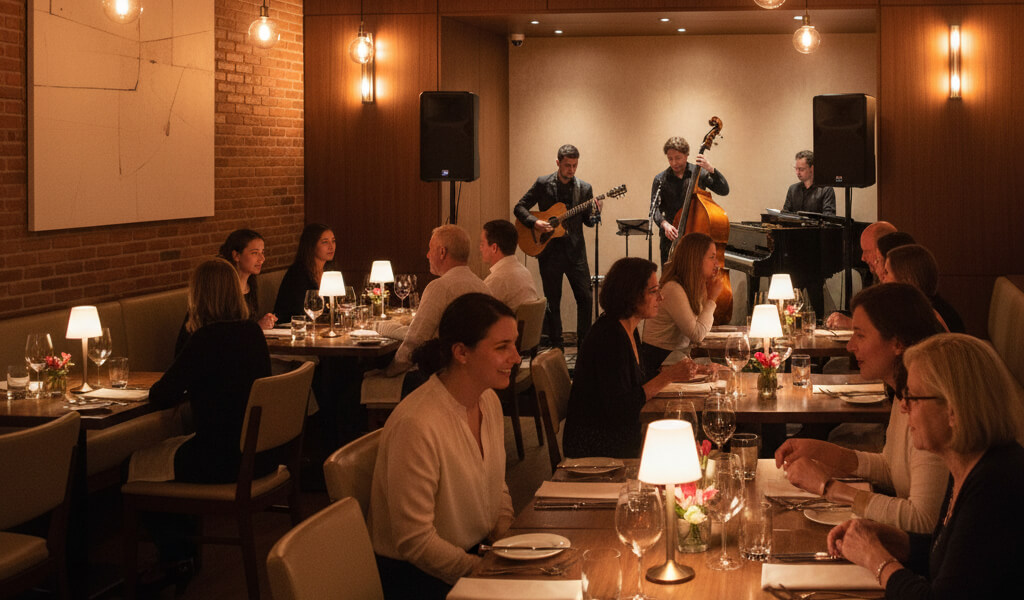October 06, 2025

Music in a restaurant isn’t just decoration — it’s strategy. From mood to meal pacing, music has a proven psychological impact on how guests perceive food, interact with staff, and even how much they spend. Whether you're running a fine-dining room, a casual brunch spot, or a fast-casual concept, your music choices help define your brand — often more than your guests consciously realize.
Let’s explore how strategic sound design can elevate both dining experience and bottom-line performance, and how to integrate it into your broader digital and operational strategy.
Music is one of the strongest environmental cues you control. The tempo, genre, and volume of your playlist set the emotional tone for the entire experience.
A landmark study from the Journal of Consumer Research found that customers subconsciously adjust their eating speed and ordering habits based on the music’s rhythm and volume. So yes — the right playlist can literally influence how long a guest stays and how much they order.
This ties into your branding. Just as poor layout or clunky site design turns customers off online, mismatched music in-store can disrupt the flow. If your website’s tone and vibe are clean, modern, and elevated, but your dining room is playing outdated or generic music, the brand experience feels fractured. To align your sound with your visual identity, revisit your digital presence to avoid common restaurant website mistakes.
It might sound strange, but studies show that music can alter taste perception. Higher-pitched music can make dishes feel lighter or sweeter, while deeper tones may enhance richness or savoriness. Classical or jazz soundtracks often raise the perceived sophistication of meals — making your dishes feel more premium without changing a single ingredient.
When you pair that sensory influence with strong visual storytelling — like elegant photography, meaningful dish descriptions, and a cohesive brand story online — you create a multisensory brand experience that resonates across touchpoints.
Restaurants looking to improve their overall customer experience (both in-store and online) should treat music as a brand asset, just like color palette, tone of voice, or plating style.
The benefits of curated sound don’t stop at the dining room. Background music has been shown to improve employee morale, reduce stress, and create smoother team communication — especially in high-volume or open-kitchen environments.
For restaurants struggling with staff burnout or high turnover, music can play a subtle role in creating a more upbeat and emotionally balanced work environment. It works best when paired with thoughtful tools and workflows that support your team’s success. As noted in Reducing Turnover With Better Tech, tech-driven solutions — like smarter scheduling and streamlined training — amplify the positive effects of culture-building elements like music and mood.
When staff feel energized and supported, that positivity transfers to guests. And in hospitality, that’s the edge that earns repeat business.
Music can also influence how — and what — guests order. For example:
Even genre matters. Research cited by Forbes shows that playing culturally relevant music (like Latin tracks in a tapas bar or jazz in a French bistro) boosts guest satisfaction and spending.
Restaurants can also leverage music to create moments worth sharing, especially during live events. If you host live music nights or curated playlists, those moments are ideal for Instagram Stories, TikTok clips, and tagged posts. This kind of content fuels digital engagement and conversion, especially when tied to campaigns like those in How to Turn Website Visitors Into Paying Diners or Using Instagram and TikTok to Drive Real Bookings.
The key? Don’t just play music — make it part of the experience.
Just like your color scheme or logo, your music should reflect your concept’s personality. Ask:
Better yet, extend that personality to your digital channels. Feature your playlists on your website, mention your music strategy on your social profiles, or even collaborate with local musicians to create community-focused experiences that align with your brand values. This sort of consistency across physical and digital spaces builds brand trust and memorability.
Music isn’t filler — it’s function. It's a tool that quietly influences how people feel, how much they spend, how they remember you, and even how your team performs.
When used intentionally and integrated with your digital presence, service strategy, and brand identity, the right soundtrack can:
It’s time to move music out of the background and into the brand strategy conversation.
Stay up to date with the latest tips, expert insights, product reviews, and step-by-step guides to help you grow, create, and succeed—no matter your industry or passion.